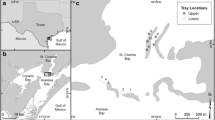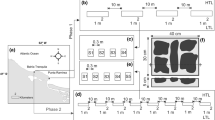Abstract
To meet demands of expanding tribal and recreational hardshell clam fisheries, the Washington State Department of Fish and Wildlife has been developing new hardshell clam habitat. In Oakland Bay, near Shelton, Washington, two artificial substrates were studied to determine the best substrate for use in improving Manila clam (Tapes philippinarum) production. Treatments consisted of a control of natural substrate; a 10 cm layer of nonuniform size gravel ranging from 6 mm to 19 mm in diameter; and a 10 cm layer of a 50∶50 mixture of gravel and crushed oyster shell ranging from 10 mm to 30 mm in diameter. Effects of these substrates on species diversity and relative abundance of existing, benthic organisms were also investigated. Recruitment of Manila clam seed, less than 10 mm shell length, was significantly higher (p<0.05) in the control plots than in the gravel and gravel + shell plots, which showed no significant differences. Recruitment improved in the gravel and gravel + shell plots after a layer of organic debris and fine sediments collected on them. Manila clam survival was significantly higher in gravel and gravel + shell plots compared to control plots. No significant differences in survival were observed between gravel and gravel + shell plots. Manila clam biomass in the gravel and gravel + shell plots was significantly higher than in control plots. Between the gravel and gravel + shell plots there was no significant difference in biomass. Minor differences in species diversity and abundance of existing benthic organisms were observed among treatments. Gammarid amphipods and nemertean worms were enhanced in gravel and gravel + shell plots. Densities of polychaete worms were slightly lower in gravel and gravel + shell plots compared to control plots.
Similar content being viewed by others
Literature Cited
Belding D. L. 1930. The soft-shelled clam fishery of Massachusetts. Division of Fish and Game, Department of Conservation, Commonwealth of Massachusetts, Marine Fisheries Series No. 1. Boston, Massachusetts.
Bonar, D. B., S. L. Coon, M. Walch, R. M. Weiner, andW. Fitt. 1990. Control of oyster settlement and metamorphosis by endogenous and exogenous chemical cues.Bulletin of Marine Science 46:484–498.
Bourne, N. andJ. Lee. 1973. Predation on juvenile bivalves by the shore crab,Hemigrapsus oregonensis andH. nudis.Proceedings of the National Shellfish Association 64:10.
Cahn, A. R. 1951. Clam culture in Japan, United States Fish and Wildlife Service, Fish Disease Leaflet 399.
Castagna, M. andJ N. Kraeuter. 1977.Mercenaria culture using stone aggregate for predator protection.Proceedings of the National Shellfish Association 67:1–6.
Ertman, S. C. andP. A. Jumars. 1988. Effects of bivalve siphonal currents on the settlement of inert particles and larvae.Journal of Marine Research 46:797–813.
Flagg, P. J. andR. E. Malouf. 1983. Experimental plantings of juveniles of the hard clam,Mercenaria mercenaria (Linne), in the waters of Long Island, New York.Journal of Shellfish Research 3:19–27.
Gallucci, V. F. andC. B. Rawson. 1979. The population dynamics and management modeling of harvested bivalves in Garrison Bay, Washington. Status report to Department of Fisheries and National Park Services. College of Quantitative Science. University of Washington, Seattle, Washington.
Hopkins, K. D. 1992. Reporting fish growth: A review of the basics.Journal of the World Aquaculture Society 23:173–179.
Hopkins, A. E., P. S. Galstoff, andH. C. McMillin. 1931. Effects of pulp mill pollution on oysters. United States Department of Commerce, Bureau of Fisheries 6:125–186.
Keck, R., D. Maurer, andR. Malouf. 1974. Factors influencing the setting behavior of larval hard clams,Mercenaria mercenaria.Proceedings of the National Shellfisheries Association 64: 59–67.
Kraeuter, J. N. andM. Castagna. 1977. An analysis of gravel, pens, crab traps, and current baffles as protection of hard clams,Mercenaria mercenarid.Proceedings of the World Mariculture Society 8:581–585.
Levinton, J. S. 1982. Marine Ecology. Prentice-Hall, Inc., Englewood Cliffs, New Jersey.
McKernan, D. L., V. Tartar, andR. Tollefson. 1949. An investigation of the decline of the native oyster industry of the state of Washington, with special effects of sulfite pulp mill waste on the olympia oyster (Ostrea lurida).Biological Bulletin 49-A:115–165.
Menzel, R. W., E. W. Cake, M. L. Haines, R. E. Martin, andL. A. Olsen. 1976. Clam mariculture in northwest Florida: Field study on predation.Proceedings of the National Shellfish Association 65:59–62.
Mottet, M. G. 1981. Enhancement of the marine environment for fisheries and aquaculture in Japan. Washington Department of Fisheries. Technical Report 69. Olympia, Washington.
Newman, J. R. andW. A. Cooke. 1988. Final impact statement for the enhancement of hardshell clam production by beach graveling. State of Washington Department of Fisheries, Olympia, Washington.
Orensanz, J. M. 1989. Studies on the growth and population dynamics of a stable native littleneck clam (Protothaca staminea) population (Garrison Bay, North Puget Sound), and its cancrid crab predators (Cancer spp.) Ph.D. Thesis, University of Washington, Seattle, Washington.
Peterson, C. H. 1982. The importance of predation and intra- and interspecific competition in the population biology of two infaunal suspension feeding bivalves,Protothaca staminea andChione undatella.Ecological Monographs 52:437–475.
Pielou, E. C. 1974. Population and community ecology, principles and methods, p. 288–315.In E. C. Pielou (ed.), Ecological Diversity. Gordon and Breach Science Publishers, New York, Paris, and London.
Scholz, A. J. 1990. Intertidal fisheries for hardshell clams and oysters, p. 66–78.In J. W. Armstrong and A. E. Copping (eds.), Status and Management of Puget Sound's Biological Resources. EPA 910/9-90-001. United States Environmental Protection Agency, Washington, D.C.
Simenstad, C. A., J. R. Cordell, and L. A. Weitkamp. 1991. Effects of substrate modification on littoral flat meiofauna: Assemblage structure changes associated with adding gravel.In Technical Report to Washington Department of Fisheries, Brinnon, Washington. University of Washington School of Fisheries, Fisheries Research Institute, FRI-UW-9111. Seattle, Washington.
Taylor, P. 1988. Washington State clam farmers' experiences, p. 180–185.In T. A. Broadly, W. E. Clayton, and W. G. Mood (eds.), British Columbia Manila Clam Culture Workshop. Aquaculture and Commercial Fisheries Branch, British Columbia Ministry of Agriculture and Fisheries.
Thom, R. M., T. L. Parkwell, D. K. Niyogi, andD. K. Shreffler. 1994. Effects of graveling on the primary productivity, respiration, and nutrient flux of two estuarine tide flats.Marine Biology 118:329–341.
Thompson, D., andW. Cooke. 1991. Enhancement of hardshell clam habitat by beach graveling. 2:521–527.In Puget Sound Research 1991 Proceedings. Puget Sound Water Quality Authority, Seattle, Washington.
Toba, D. R. 1992. The effects of substrate modification on hardshell clams. Master's Thesis, University of Washington, Seattle.
Toba, D. R., D. S. Thompson, K. K. Chew, G. J. Anderson, andM. B. Miller. 1992. Guide to Manila clam culture in Washington. Washington Sea Grant Program, University of Washington, Seattle, Washington.
Williams, J. G. 1978. The influences of adults on the settlement, growth, and survival of spat in the commercially important clam,Tapes japonica DeShayes. Ph.D. Dissertation, University of Washington Seattle, Washington.
Williams, J. G. 1980. Growth and survival in newly settled spat of the Manila clam,Tapes japonica.Fishery Bulletin (U.S.). 77:891–900.
Yoccoz, N. G. 1991. Commentary: Use, overuse, and misuse of significance tests in evolutionary biology and ecology.Bulletin of the Ecological Society of America. 72:106–111.
Author information
Authors and Affiliations
Rights and permissions
About this article
Cite this article
Thompson, D.S. Substrate additive studies for the development of hardshell clam habitat in waters of Puget Sound in Washington State: An analysis of effects on recruitment, growth, and survival of the Manila clam,Tapes philippinarum, and on the species diversity and abundance of existing benthic organisms. Estuaries 18, 91–107 (1995). https://doi.org/10.2307/1352285
Received:
Accepted:
Issue Date:
DOI: https://doi.org/10.2307/1352285




